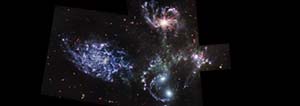UA Astronomer, Dr. George Rieke, comments on new James Webb Space Telescope images

Regents' Professor George Rieke, the Science Lead for the JWST MIRI Instrument, gives us his view of the first images from JWST:
"It is gratifying to see how the first images and results from the James Webb Space Telescope have swept the world and given so many people a respite from humanity’s problems. If it is possible, it is even more gratifying to the teams at Steward Observatory who have been working and supporting the development of two of the four instruments on Webb – the Near Infrared Camera (NIRCam) and the Mid-Infrared Instrument (MIRI). Our roles in these instruments began more than twenty years ago for a few now-grizzled veterans, and as long as ten years ago for the many young astronomers who joined us. They took a huge gamble with their early careers by investing their energies in something with an uncertain and, on their timescale, far future payoff. But it has worked out for them, and amazingly well since the Webb observatory is working even better than predicted.
“Our” instruments showed what they can do in the Early Release Observations. NIRCam provided the ultra-deep image of the sky centered on a massive cluster of galaxies. It shows intriguing arcs of galaxies far behind the cluster, whose light has been bent by the gravitational field of the cluster and concentrated toward our direction. This is a foretaste of the large program we will be conducting over the next year to search for proto-galaxies back toward the birth of the Universe.
Both NIRCam and MIRI were featured in the image of the Stephan’s Quintet – five galaxies, of which four are interacting and in the process of merging. The image by MIRI shows spectacularly the flocculent structure of the interstellar gas and dust in one of the galaxies, and is symbolic of the new perspectives that this instrument will provide by observing at longer wavelengths than NIRCam.
The Southern Ring highlights both instruments. Although this planetary nebula is 2000 light years away, NIRCam resolves details as small as the Solar System, a foretaste of the incredible detail Webb will show us for everything it looks at. Both images, but particularly that from MIRI, reveal complex scallops of dusty shells. These were thrown off as a star went unstable and pulsated while gravity pulled it to its ultimate demise, with only its core surviving as a faint white dwarf star in the center of the nebula."

For Public
Public events include our Monday Night Lecture Series, world-reknowned Astronomy Camp and Mt Lemmon Sky Center.

For Students
A good place to start if you want to become an undergrad major or grad student, or need to find our schedule of classes.

For Scientists
Find telescopes and instruments, telescope time applications, staff and mountain contacts, and faculty and staff scientific interests.




